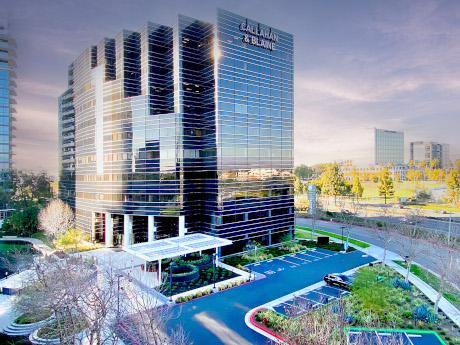— By Nellie Day —
Employers all over the nation are looking for ways to bring employees back into the office. In many cases, it’s been a large ask, as employees have adapted to the work-from-home environment and its perceived perks.
One of the biggest strategies employers have undertaken is creating an enticing environment where employees want to be. This can include intriguing office spaces, useful amenities, opportunities for socializing and beautiful outdoor spaces. This strategy can go even further when local businesses and municipalities work together. Such is the case with South Coast Metro Alliance, a non-profit corporation of Orange County, Calif.-based property owners and major businesses that have a long-term investment in the area through ownership and/or long-term leases. The economic development organization, which encompasses north Costa Mesa and south Santa Ana, has worked to ensure employers are proud of the spaces they can offer their employees — and that, in turn, employees are excited to return to the office.
WREB spoke to Diane Pritchett, executive director of the South Coast Metro Alliance, to discuss the specific strategies employed by businesses and the South Coast Metro Alliance to reactive the local office environment.
WREB: How has the introduction of popular food trucks and live entertainment at South Coast Metro office complexes impacted employee satisfaction and productivity?
Pritchett: Food trucks and live entertainment have positively impacted employee satisfaction and productivity for South Coast Metro office workers. These are the kinds of employee-focused services and experiences many companies believe they need to be competitive in the labor market as they evolve to meet employee demands.
For example, employees working at the MET Costa Mesa say they appreciate the value they receive from the partnership created with various local companies that bring preferred pricing and special offers, such as reduced costs for boarding and other pet services, as well as group activities like yoga classes. Special events like the recent summer fair held at the MET gave employees another reason to be onsite. Keeping employees on campus increases the opportunity for greater productivity. Staying on site means they don’t have to drive or walk to a restaurant or repark their cars. It also results in greater satisfaction as these amenities are available just outside.
WREB: In what ways have outdoor workspaces and the presence of outdoor artwork influenced the appeal of South Coast Metro office spaces to remote workers considering a return to the office?
Pritchett: Few locations offer the balanced, people-centered workplaces where business meets lifestyle that South Coast Metro does. The pedestrian-friendly community draws workers back to their offices with easily accessible amenities like international retail, public artworks and performing arts. There are also diverse culinary experiences, hotels and upscale residential housing. As more and more employees are being told to return to their office, South Coast Metro’s many attractions can sweeten the transition considerably.
WREB: What feedback have employers and employees provided regarding the integration of these new amenities, and how has it affected the overall work culture in South Coast Metro?
Pritchett: The emphasis at South Coast Metro is on the experience. Striking architecture is balanced by environmentally friendly workplaces — often within Class A office buildings — that combine state-of-the-art technology, quality construction and distinctive interior design.
For example, Pacific Arts Plaza is home to the California Scenario, a 1.6-acre sculpture garden designed by Isamu Noguchi that represents the diversity of California’s landscape. It’s a remarkable art installation. The Plaza also offers a private, state-of-the-art fitness center with high-tech cardio, strength training equipment and day-use lockers. A work-ready outdoor relaxation space called the Commons offers shaded seating, a firepit and game area. There’s also a social space with ping-pong, a pool table and more, along with indoor-outdoor meeting and event space. Other employee-friendly features include an ATM, car wash and detailing, a customer resource center, dry cleaning, EV charging, package services and secure storage solutions.
WREB: How do the costs and benefits of enhancements like live entertainment and food trucks compare to more traditional office improvements like upgraded interior office spaces or increased technological infrastructure?
Pritchett: In many cases, upgraded interior office spaces and increased technological infrastructure are a given for employees. They expect their employers to be competitive with up-to-date technology and appealing workspaces. Having the other enhancements available helps bridge the psychological and physical gap from home to office. They also demonstrate to employees that they’re valued while helping to create moments that matter. These less-formal opportunities to interact with senior management and their peers can be priceless. Informal gatherings of other company employees who are not regularly in the area held at these amenities help build team spirit. Creative sessions can happen. Ideas can be generated.


